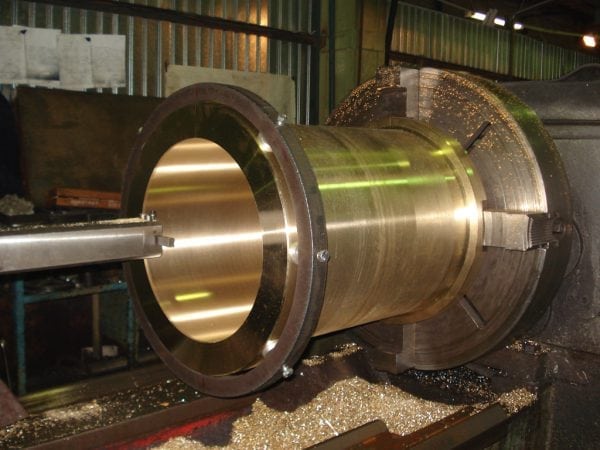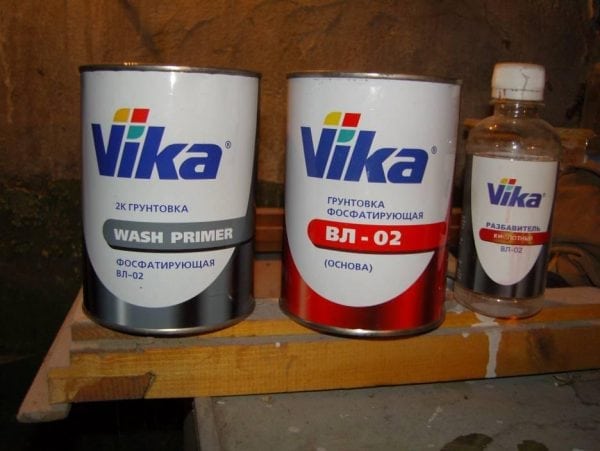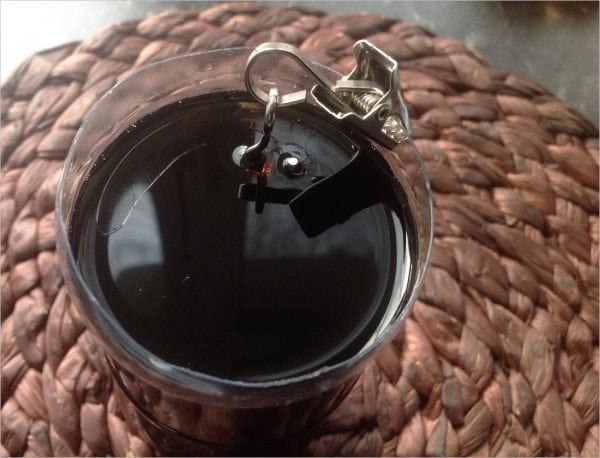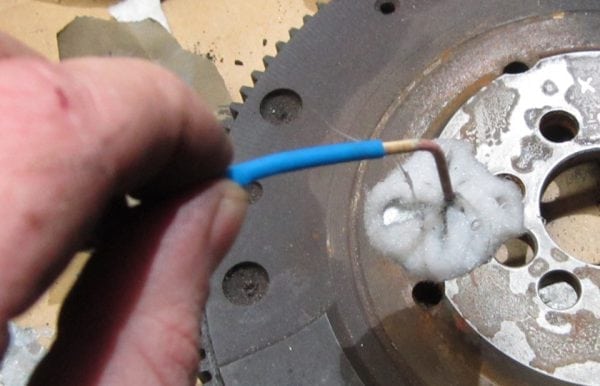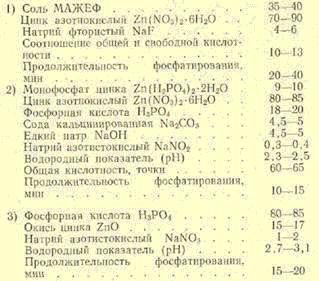Phosphating is the processing of metal by special means based on phosphate salts, as a result of which a protective film appears on the surface. Among the options for protecting metal from corrosion by phosphating, the most known phosphating primer. Hydroabrasive phosphating and chemical treatment of metal are also used. In addition to protecting the metal, the film provides increased adhesion (adhesion) of the metal to paints and varnishes.
- Waterjet Phosphating
- Phosphating Primers
- Chemical processing of steel
- Accelerated salt treatment MAJEF
- Accelerated Zinc Salts
- Cold process
- Phosphating at home
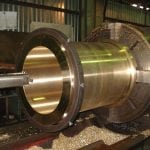
Waterjet Phosphating
Waterjet processing is considered one of the best ways to protect metal. The composition for metal processing is prepared on the basis of soft water. Details are dipped for 10-15 minutes in a 10% solution of potassium dichromate. Fluid temperature - from 70 to 80 degrees Celsius.
Next, the film is hydrophobized, for which the product is placed for 7 minutes in a 10% solution of organosilicon liquid in gasoline. After that, gasoline vapors are allowed to evaporate in the open air and the metal is sent for drying at 100 ° C for an hour.
to contents ↑Phosphating Primers
To protect the metal, a phosphating primer can be used, 9/10 consisting of metal pigments, as well as a solvent based on phosphoric acid. When interacting with an electrolyte, zinc-containing paint is strengthened by corrosion products and forms a dense film.
Phosphating primers are used for processing products from ferrous and non-ferrous metals of any size (from large structures to threading a single part). Primed surface leads to passivation of the metal, as well as improving the adhesion properties of the material.
to contents ↑Chemical processing of steel
Chemical phosphating is the dipping of a metal into special chemical compounds, as a result of which a protective film appears on its surface.
Put the Majef salt in the bath, based on the proportion of 35 grams per liter of water. Fill the liquid, bring it to a boil and keep it in this state for 20 minutes. Next, remove the container from the fire to determine and correct (if necessary) the level of acidity.
The composition is made in excess, since during heating part of it disappears. The level of total acidity is determined by phenolphthalein titration. To titrate 10 milliliters of a solution, 30 milliliters of decinormal sodium hydroxide composition will take. Free acidity will be revealed in the presence of a methyl orange indicator.
To titrate a 10-milliliter sample, 4 milliliters of decinormal sodium hydroxide solution is needed. The amount of alkali spent on titration is indicated in points. Indicators of acidity: total - 28-30 points, free - 3-4 points (that is, the ratio of different types of acidity among themselves can vary from 7 to 10).
Phosphating is carried out at a temperature of 98 degrees Celsius for 1-2 hours.
The work can be considered finished when the hydrogen bubble stops. Next, the metal is aged in the tank for 10-15 minutes. This is necessary for the crystallization of the film.
The MAJEF consumption rate for phosphating a square meter of the surface can range from 120 to 140 grams. The level of acidity is adjusted by water or by adding Majef salt. The specific amount of salt required to achieve an acidity level of 30 points can be calculated by the formula:
A (kg) = (30-n) * V / 1000
Variable V means volume, and n is the number of points in the solution. If the steel has a large proportion of alloying components (copper, chromium, vanadium), it will not work to obtain a film of proper quality. The presence of components of aluminum, lead, arsenic, as well as chloride and sulfide impurities in the solution reduces the quality of work. The proportion of chlorine ions should not exceed 0.3%.
If the film turned out to be of low quality, it can be removed using a 15% hydrochloric acid solution or a heated 20% sodium hydroxide solution. It should be borne in mind that in the case of repeated phosphating, the film will have a larger crystalline structure with lower protective qualities.
to contents ↑Accelerated salt treatment MAJEF
Phosphating of low-alloyed and electrotechnical grades of steel is carried out using mixtures that include the following components (grams per liter of water):
Option number 1
- MAZEF drug - 30-40;
- zinc nitrate Zn (NO3)26H2O is 50-60.
Option number 2
- MAZEF drug - 45-50;
- zinc nitrate Zn (NO3)26H2O - 70-80:
- sodium fluoride NaF.
Phosphating is carried out in just 10-15 minutes under the condition of a liquid temperature of 97-98 degrees Celsius for solution No. 1 and solution No. 2. Without cleaning the surface, the procedure can be performed by adding zinc oxalate to the composition. This substance will remove traces of corrosion during the formation of the film.
The content of the solution (grams per liter):
- zinc monophosphate - 35;
- zinc nitrate - 53;
- phosphoric acid - 14;
- zinc oxalate - 0.1.
The permissible level of total acidity is 70-80 points, free acidity is 12-15 points, the temperature of the liquid is 92-98 degrees Celsius, the phosphating time is 20-40 minutes.
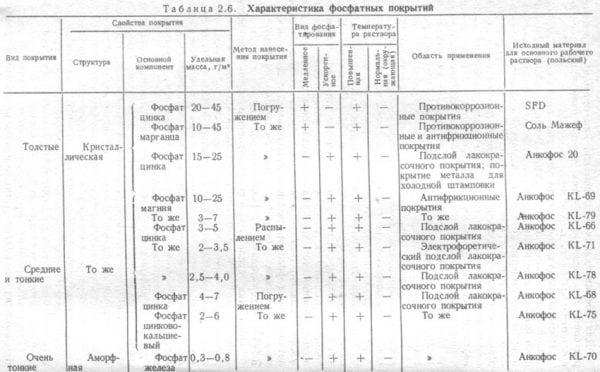
Zinc oxalate is prepared from sodium oxalate and zinc nitrate. When combining the solutions at the bottom of the tank, a precipitate of zinc oxalate is formed, which must be removed using a filter. Next, the precipitate is dried and used to create a phosphating solution.
to contents ↑Accelerated Zinc Salts
Processing of metal in a solution of zinc salts allows to provide better surface protection in comparison with the Majef salt.
The components of the composition (grams per liter):
- zinc monophosphate - 37;
- zinc nitrate - 54;
- phosphoric acid - 16.
During phosphating, a composition adjustment will be required. To do this, you need to add a concentrate, which includes 500 grams of zinc nitrate, 480 grams of zinc monophosphate, 180 grams of phosphoric acid and a liter of water.
A black film with enhanced protective characteristics is obtained by sequentially dipping parts in two compositions. One of them contains 1 gram of soda ash, 23 grams of ferrous phosphate, 8 grams of zinc oxide, 32 grams of phosphoric acid (all quantities are indicated per liter of water). The total acidity of the composition is from 56 points, and free - from 9 to 14 points. The fluid temperature is from 92 to 97 degrees Celsius.
After dipping in the above solution, the product is placed for 5 minutes in a 9% potassium chrompick solution at a temperature of 80 to 95 degrees Celsius. Next, the part is again washed in a soap-soda solution, and then in hot water and placed in a container for re-phosphating. This time the mixture includes 150 grams of zinc nitrate, 30 grams of Majef, 3 grams of carbonic acid. Acidity index - from 80 points, free acidity - from 2 to 4 points. The temperature of the composition is from 50 to 60 degrees Celsius, the phosphating period is from 10 to 20 minutes.Next, the product is placed in a soap-soda solution for 2 minutes. The process ends by drying the film and treating it with mineral oil.
to contents ↑Cold process
Cold phosphating involves treating the material at a temperature of 20 to 40 degrees Celsius. You can use one of two types of solution.
To work, you will need the following components (based on grams per liter):
Solution No. 1. We load the amount of MAJEF salt corresponding to the volume of water into the bath. Add boiled and infused sodium fluoride, and zinc nitrate to the solution. To increase the acidity level of the solution, add 1.5 grams of Majef salt, 2-3 grams of zinc nitrate and 2-3 milligrams of sodium fluoride to each point.
Solution No. 2. To create a solution, we use a concentrate, which includes 80 grams of zinc monophosphate, 750 grams of zinc nitrate, 160 grams of phosphoric acid, 40 grams of soda ash and 1 liter of water.
To prepare 100 liters of working solution, we add 12 liters of caustic soda concentrate (300 grams per liter) to 85 liters of water, and then add water to the level of 100 liters. We also fall asleep 40 grams of sodium nitrate. If the acidity is less than necessary, a little caustic soda is added.
to contents ↑Phosphating at home
The phosphating process can be carried out independently. The easiest way to do this is in a quick way. To do this, you need to make a solution based on the Majef salt and zinc nitrate. After mixing the components and heating the liquid to the boiling point, the metal product is placed in a container with the mixture for 15 minutes.
Note! To paint a phosphated surface is possible only after its final drying.
Although phosphating can be carried out outside the production environment, certain knowledge and qualifications are still required to carry out the work. Therefore, if there is no self-confidence, it is better to entrust this process to specialists who will provide such a service quickly and efficiently.

